The following day we had the morning free, so my friend Sneža and I agreed to spend it in any way each one of us liked. So, she went to the hotel roof to stay by the swimming pool, while I returned to Don Bosco Sanctuary again, since I wanted to see the church from the inside when the Sun was shining.
First, however, I decided to walk there and then I realised it was much closer to our hotel than what I had thought before. During the previous couple of days we moved in that area only by buses. Admittedly, this was partially on account of the darkness and although the church is in one of the main streets, when you don’t know the area, dark and deserted streets may seem a little intimidating. However, in the middle of a day, I easily covered the distance on foot and this time, on a sunny day, the effect was impressive.
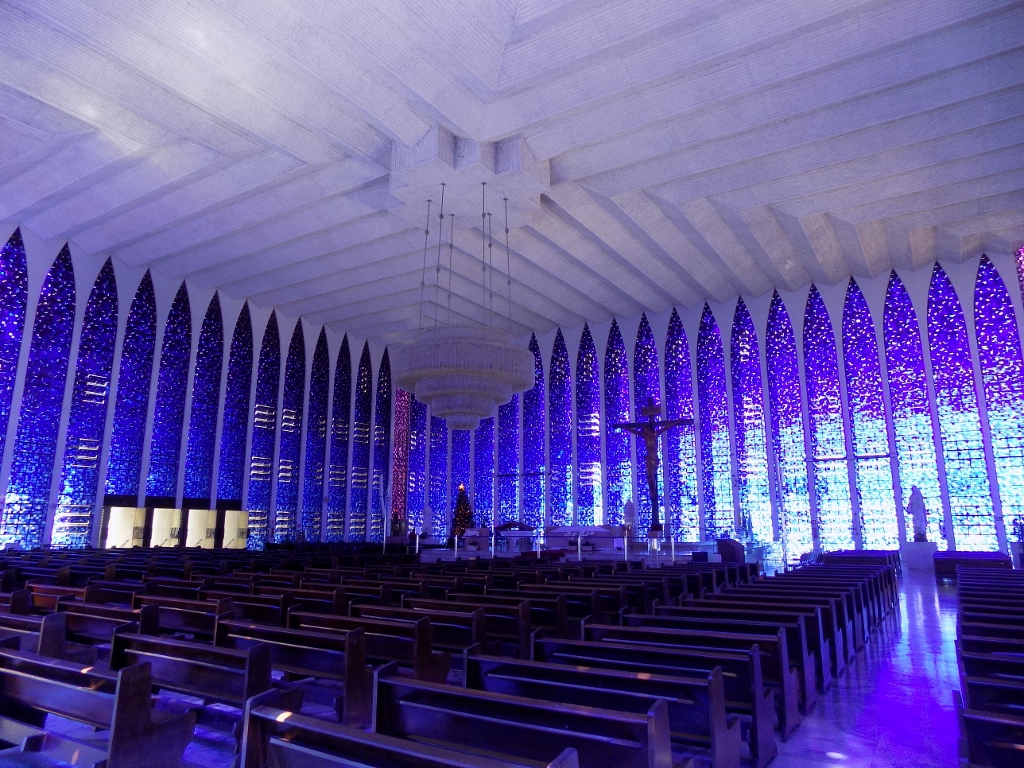 Don Bosco Sanctuary
Don Bosco Sanctuary
This is in fact a modern and blue-coloured version of the Sainte-Chapelle of Paris (you can see my video recording of the Paris chapel on: https://www.svudapodji.com/en/paris-5/).
And here you can see my video recording of Don Bosco Sanctuary:
Now, let me finally say something about the church itself. It has a square ground plan, with each side being 40 m long. On each side, there are 20 columns and they are 16 m high. Between them, the walls are filled with glass squares and all these fillings but one on any of the sides are made of blue glass. Moreover, the author used 12 shades of blue in order to symbolise the beauty of the sky in Brasilia. That one segment of the wall of each side that is not blue was made in the shades of purple.
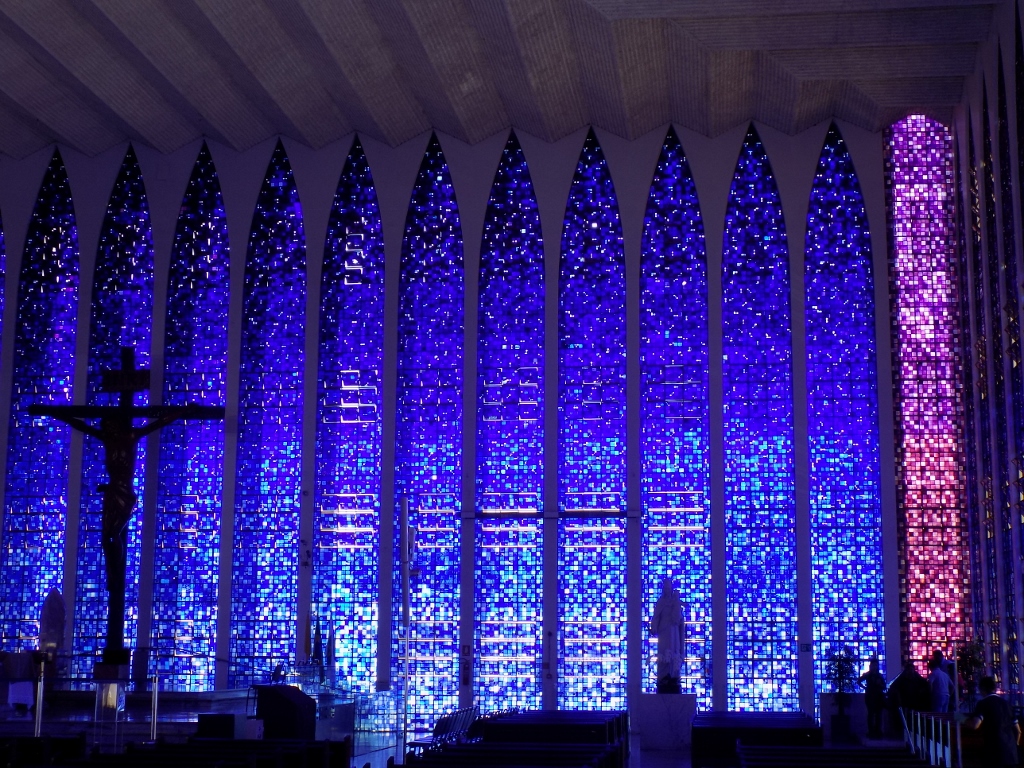 Don Bosco Sanctuary
Don Bosco Sanctuary
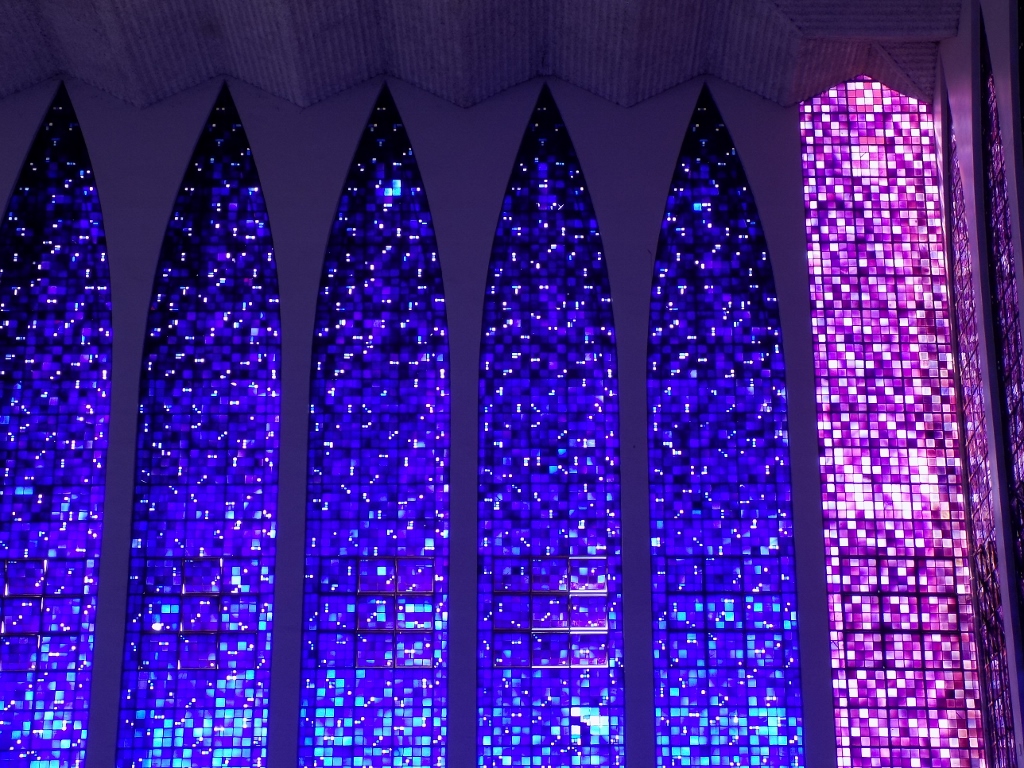 Don Bosco Sanctuary
Don Bosco Sanctuary
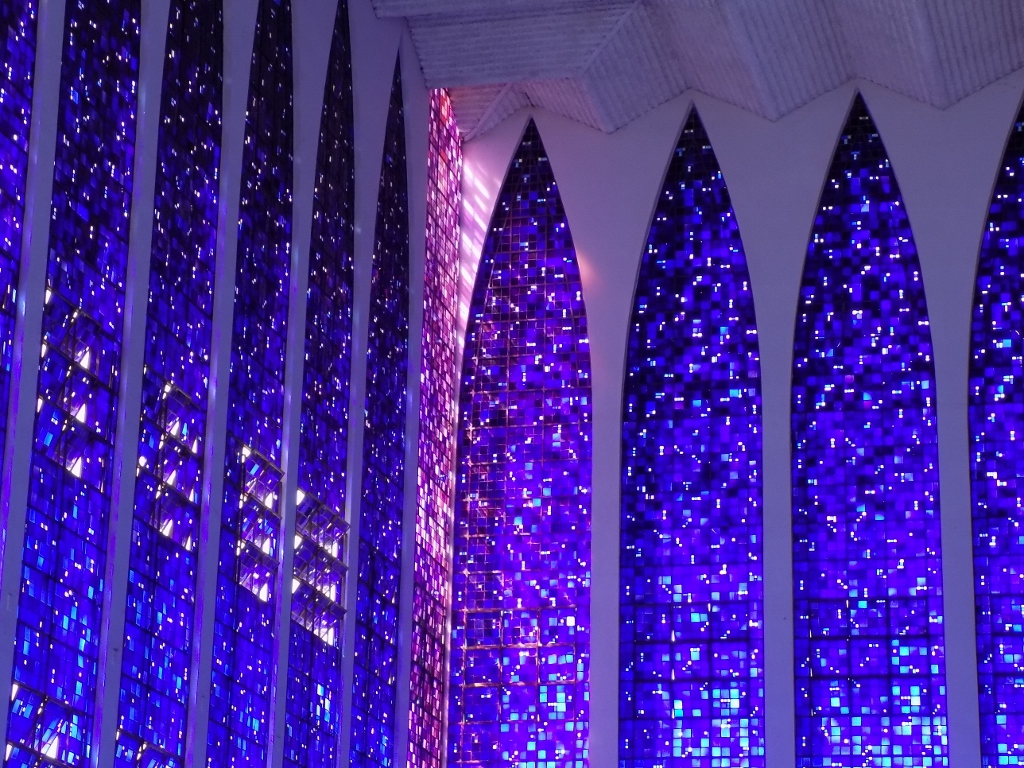 Don Bosco Sanctuary
Don Bosco Sanctuary
Still, the blue colour is the dominant one.
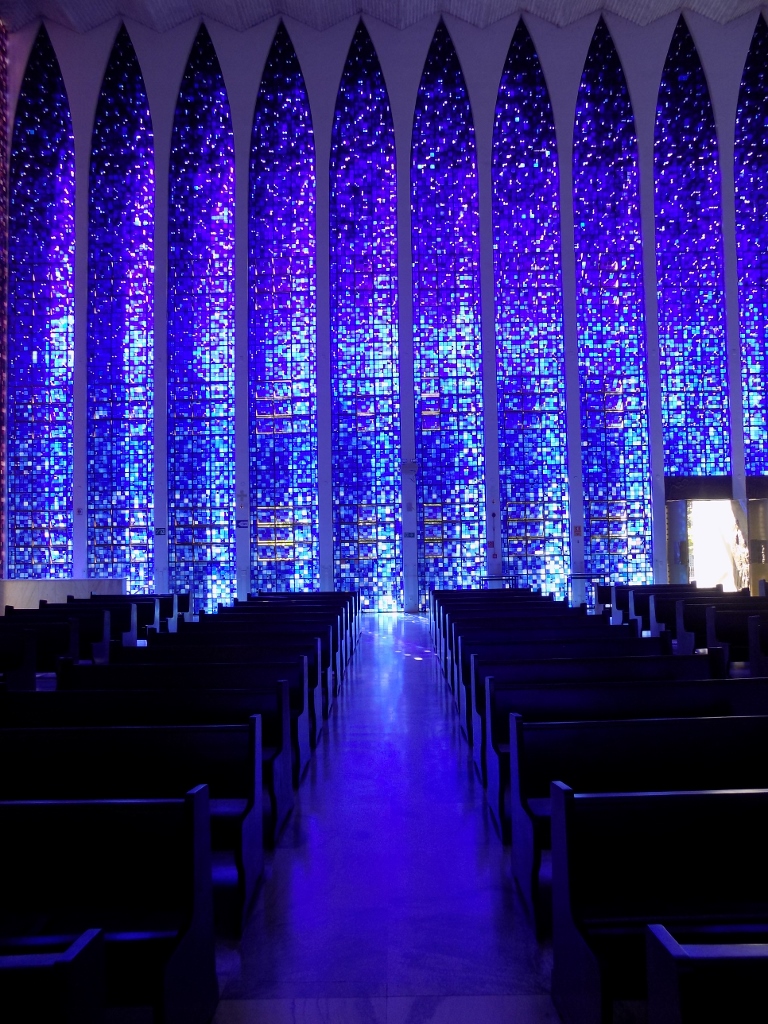 Don Bosco Sanctuary
Don Bosco Sanctuary
There was peace and harmony that I could feel inside, there was quiet music playing (although quite a lot of noise came from the traffic outside) and the air was also quite pleasant. This was made possible by the doors opened on three sides, plus there were also “windows” that could be opened and yet without disturbing in any way the entire appearance.
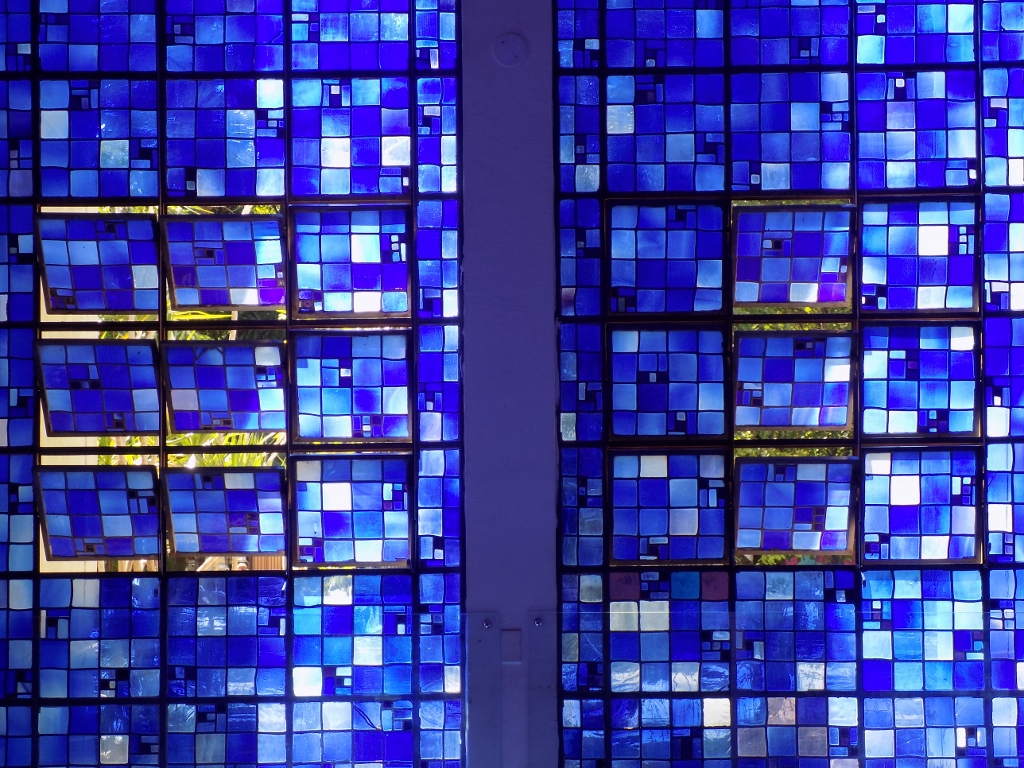 Don Bosco Sanctuary, the “windows”
Don Bosco Sanctuary, the “windows”
The only source of artificial light which the two of us had actually seen the night before is the huge chandelier in the middle made of Murano glass with over 400 light bulbs symbolising Christ who is in the spiritual sense the only source of light.
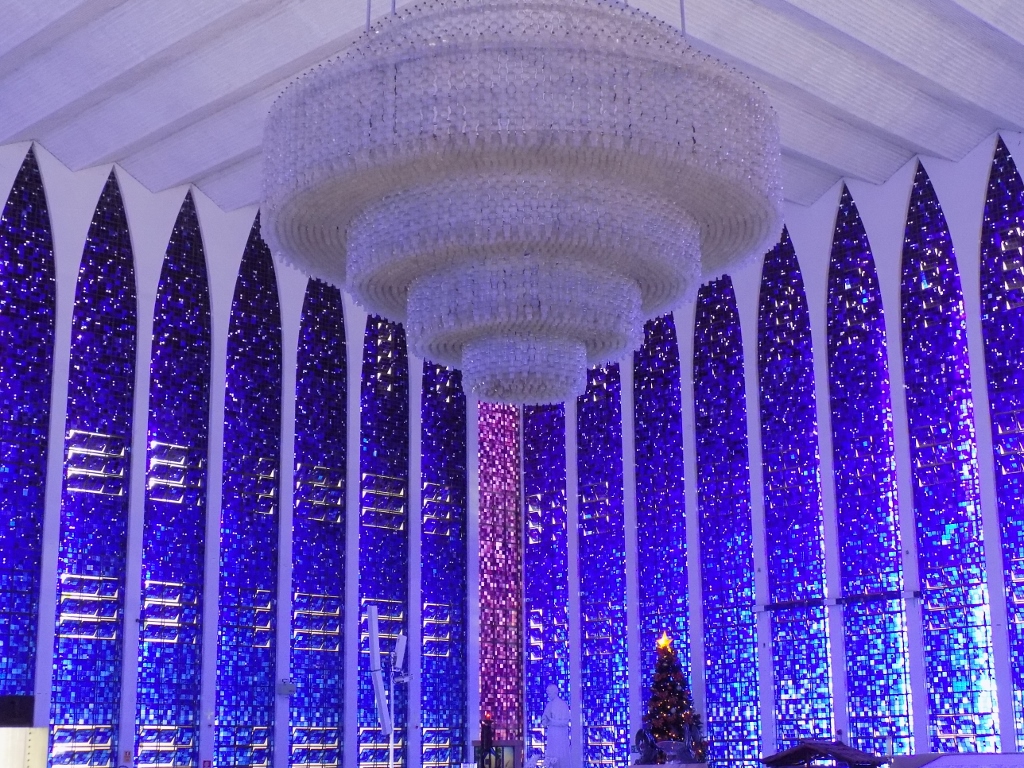 Don Bosco Sanctuary, the chandelier
Don Bosco Sanctuary, the chandelier
In the upper photo below, by the Christmas tree, it is possible to see the statue of St John Bosco to whom the church is dedicated. I wrote about him in my previous text (Brazil 2019, part 11).
With no rush I walked around the church, including also the crypt, and then I went out in the street again heading for the hotel. I was to cross once again the enormous street that runs around the central lawns-green area, which all together forms the Monumental Axis.
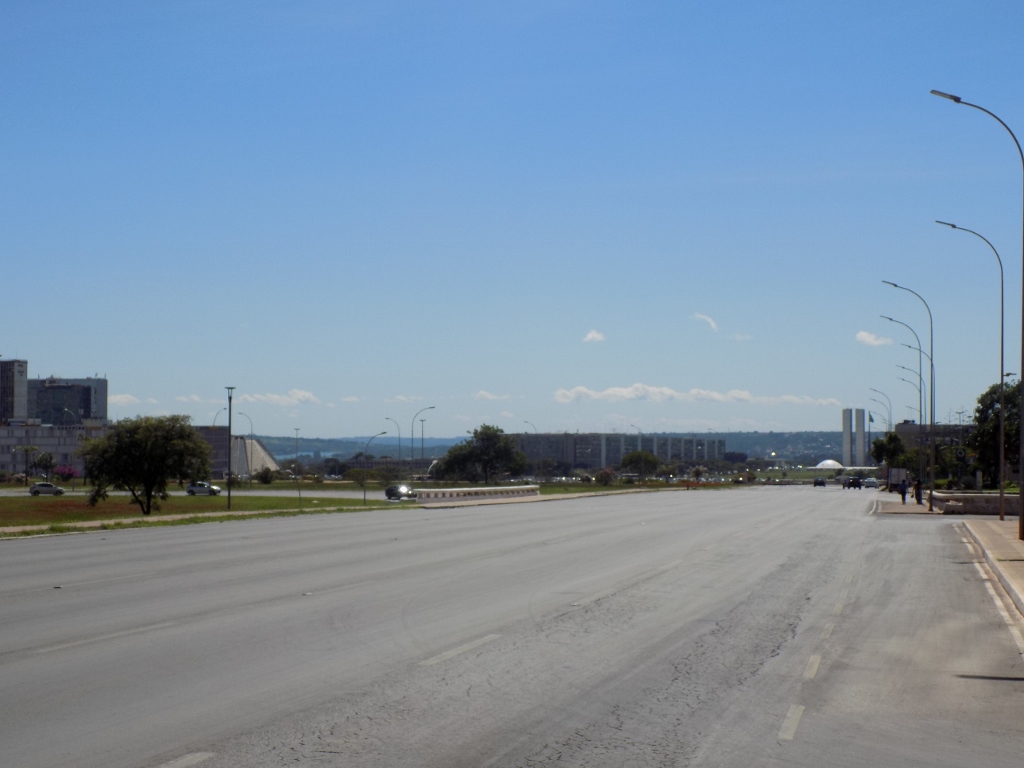 Brasilia, down the avenue one can see the National Congress
Brasilia, down the avenue one can see the National Congress
After we had packed up, we went to the airport since our next destination was the city of Salvador on the coast of the Atlantic Ocean. If one goes by coach, the journey takes around 22 hours and that was certainly an experience the two of us were ready to skip. We had been doing our fair share of travelling by coaches around this enormous country anyway.
I was generally impressed with the order that exists in some aspects in Brazil. While we were waiting to board the plane, I could admire the system they have. This time it consisted of four lines separated by stanchions and ribbons. The plane was first boarded by people who needed assistance, i.e., those who were in wheel-chairs and unaccompanied children, and they were not waiting in any of the four lines, which is more or less the usual practice around the world.
Then it was the turn of the first line – these were the elderly and people with small children. Only then boarded the passengers of the business class. Then came the file of people who did not have any luggage, except a handbag/backpack, and finally it was the turn of those who in addition to a handbag/backpack also had a small suitcase. They all waited in their respective lines separated by the ribbons and everything went smoothly and quickly.
Since I’m talking about the impressions I got by merely watching the scenes around me, let me mention the following. There were three things that I found rather visible. First, a lot of girls have dental braces. It is nice that they take care of their teeth.
Second, when we went to cafés, they regularly had on the tables or the waiters offered calorie-free sweeteners. I don’t know if this was the question of avoiding sugar on account of diet, i.e., on account of the bodily figure or because of a possible high prevalence of diabetes and then at the national level they are trying to make sure the sugar intake is lowered. On the other hand, it is evident that there is so much junk food, sweets and all sorts of “chemical” beverages around, so I’m afraid that saving on a little bit of white sugar per cup of coffee will not help them a great deal. Also, it was clear from the breakfasts we had in different accommodations that Brazilians love pastry and cakes which are made of sugary batter and this is obviously consumed at a grand scale, has a lot of calories and is bad for the sugar levels in the blood, since the batter also contains carbohydrates in the shape of starch, which is also not good.
The third and perhaps the weirdest thing I noticed were big pillows which a large number of people we encountered at coach terminals and airports carried in their arms – a backpack and/or a handbag and a relatively big pillow. I did not quite understand it, that sentimental attachment to one’s personal pillow, because I was thinking how it would bother me while travelling and moving all my things, but then again, nobody asked me to carry it and whoever likes it is free to take his pillow along.
When we landed at the airport in Salvador, we were greeted by a taxi driver we had arranged with the owners of the hostel we had booked. During the drive, I was rather confused on account of the time shown by the clocks and the duration of the flight, nothing made sense to me, so I planned to check it out as soon as we got to the room. In the meantime, the night started to fall.
When we got to the hostel, where we actually booked a small flat, and got out of the taxi we were met by some locals who did not seem welcoming to us. Our first impressions were based on the fact that it was very noisy, some of the locals seemed drunk or stoned, but this all had more to do with us just arriving, the night was falling, the street was old, the small shops and cafés seemed crumbly, and when you see all of this in the dark, it is possible to start fantasizing. Many years ago, poor me got extremely scared like this in the middle of Geneva and I even checked outside the window of my hotel room in case I would have to jump out should there be any panic and I comforted myself that I was on the second floor, with an awning below. Of course, in the morning it was perfectly clear to me that this was only my scared imagination at work, but to my defence I was rather young and with little experience in independent travelling.
Still, while we were unpacking and slowly relaxing at that flat in Salvador, I looked on the internet for information about the time zones in Brazil. It turned out that during certain period of the year, when there is the daylight-saving scheme, a town that is more to the east (e.g., Salvador) may be one hour behind a town that is more to the west (e.g., Brasilia). In other words, it would be 6 pm in Brasilia and 5 pm in Salvador. One would expect the reverse. So, I wrote a brief text on the subject of Brazilian peculiarities that we had encountered over the last couple of days.
O tempora o mores!
Since we are in the south hemisphere, the things are a bit unusual or rather up-side-down. And here I’m not thinking only of some celestial events, the position of the Moon, its waxing and waning in the opposite direction in comparison to the north hemisphere, etc., but I’m thinking of the following.
Yesterday we took a coach to go to Pirenópolis and there we visited what we wanted, but we had not bought the return tickets in Brasilia since we did not want to limit ourselves in terms of the time. When you buy coach tickets in Brazil, you need to present a personal document and we regulated this by having a copy of our passports on the same piece of paper. So we spent two week roaming around the country using this copy. And then we arrived to the coach terminal in Pirenópolis, right on time to catch a coach at our preferred time, and then we came across a zealous ticket vendor who said: “Give me the original document!” – “We left it at our hotel” – “Then, this can’t be done!” What???? She said much more in Portuguese, but neither the little voice inside of me nor I understood anything apart from the fact that we could not buy the tickets and that the woman working at the counter mentioned some “motorista” which we jointly concluded had to be the driver. While telling us all of this, the woman made a very angry face expression, just to add some level of seriousness to this whole story.
At this point Sneža and I got completely confused. It seemed futile to try to explain to the woman that we had already arrived by the same coach company from Brasilia that day and that the copies of the passports were quite fine when we bought these tickets. So, the two of us made a circle around the terminal, hoping to see somebody who would seem to be a person that can solve our problem, but apart from a few of other passengers there was nobody else around. Luckily, there were two young women who realised there was a problem (Sneža and I also have our face expressions for extraordinary situations), so they told us they spoke some Spanish and asked what this was all about. After our explanation, they went to the counter and then they returned with the report. We could definitely not buy the tickets at the counter, but perhaps we could try it with the driver. If that did not work, then we should go to the police in Pirenópolis in order for them to certify the copy and confirm that it was true to the originals (which were still duly stored at the hotel room’s safe some 150 km away). We did not quite grasp this local custom, but we hoped to encounter a kind-hearted coach driver. While we were waiting for the coach that was around one hour late we had the time to come up with alternatives. We concluded that if nothing else worked we would have to catch a taxi and then we spent half an hour convincing each other that 200 euros should cover the cost (they were also at the hotel room some 150 km away). The driver of the coach that eventually arrived was young and obviously inexperienced and not well-versed about the unwritten code of the profession. With a very strict expression on his face (here we go again), he was not to be persuaded lightly although, as evidence of my moral standing and the position in the universe, I showed him the card from the hotel with my name on it and the number of the room. Perhaps he just thought I was telling him I had an empty room and he was just about to get married and did not feel like cheating on his fiancé. Be as it may, an elder colleague of his appeared who was actually in charge of a completely different coach, but that did not prevent him from saying we could get on the coach we wanted. In fact, he said much more than that, perhaps he wanted to take me up on the offer of my empty room, but as soon as we put our feet into the coach, none of this mattered any longer to anybody, even to that little voice inside of me that is in charge of communication.
Today we used quite a different type of transportation, an airplane, we had the original documents and everything went smoothly except that I thought the flight’s duration was 50 minutes, since we were to land in Salvador at 5 pm. It turned out that the flight took one hour longer and so we landed at 6 pm, since we departed around 4 pm. Still, this did not make much sense. How is it possible that the flight lasted twice as much and yet nothing happened and we did not circle? Then we looked at the clocks around us and realised that we did land at 5 pm. But, how is that possible? We flew to the east! I guess we should have landed at 7 pm if this was a question of another time zone.
Nothing made sense until we reached the hostel and I looked it up on the internet. There are several time zones in Brazil and some of them are practically divided along the north-east line. O tempora o mores!
The main advantage of the accommodation we had in Salvador was that it was within the historical centre of the city. This historical centre of Salvador called the Upper City spreads across two hills – Pelourinho and Carmo. We stayed in Carmo.
So, after we had left our things and refreshed a little, we did go out because it was not too late after all, so we walked to the central square that is on the top of a hill. Along the way we passed by the Church of Our Lady of the Rosary of the Black People (Igreja Nossa Senhora do Rosário dos Pretos). At some point in time, the king of Portugal gave the land for the construction of this church intended for the slaves and it took them around 100 years to finish it.
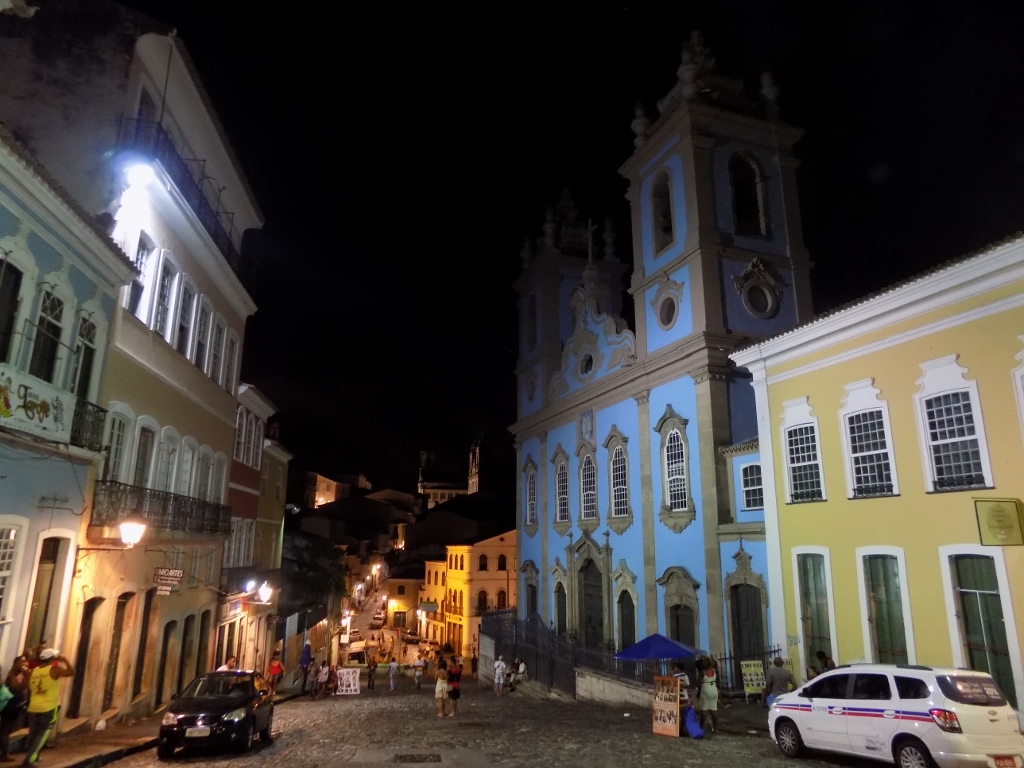 Salvador at night, the blue edifice on the right-hand side is the Church of Our Lady of the Rosary of the Black People
Salvador at night, the blue edifice on the right-hand side is the Church of Our Lady of the Rosary of the Black People
Already the church belonged to the part of the city called Pelourinho on top of which there are a couple of squares that practically extend one from the other.
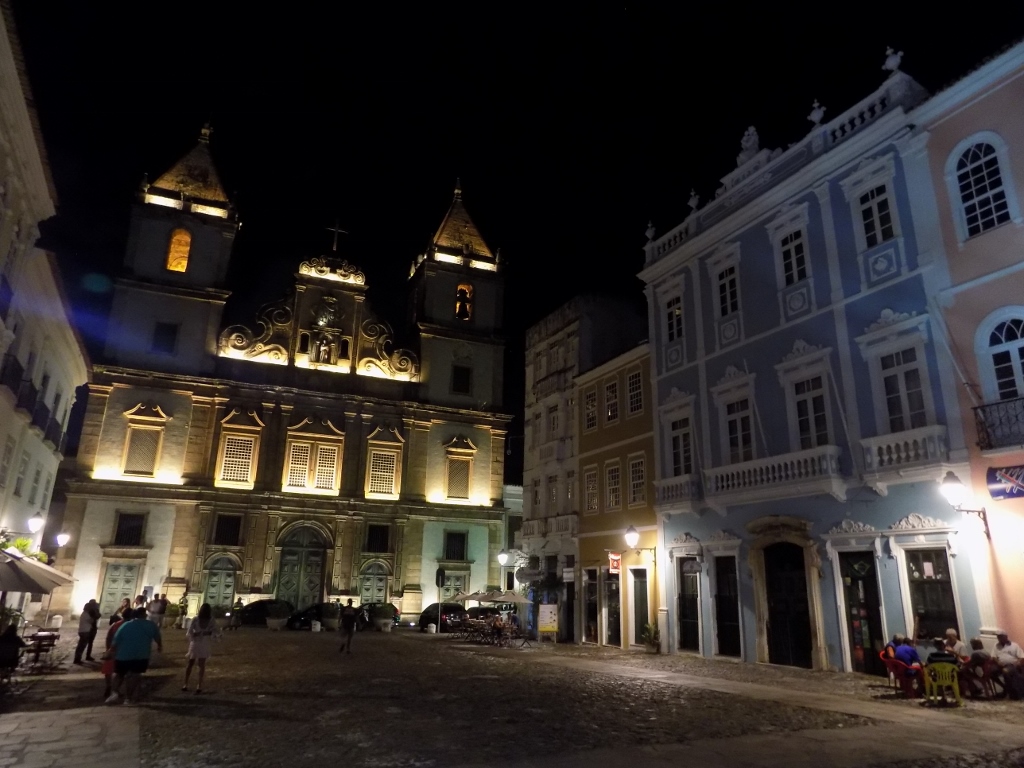 Salvador at night, Church of St Francis and the surrounding buildings
Salvador at night, Church of St Francis and the surrounding buildings
In one of those squares we sat down in one of the cafés-restaurants, had something to eat and each one of us ordered a beverage of our choice. This time I opted for a caipirinha, practically the national drink of Brazil.
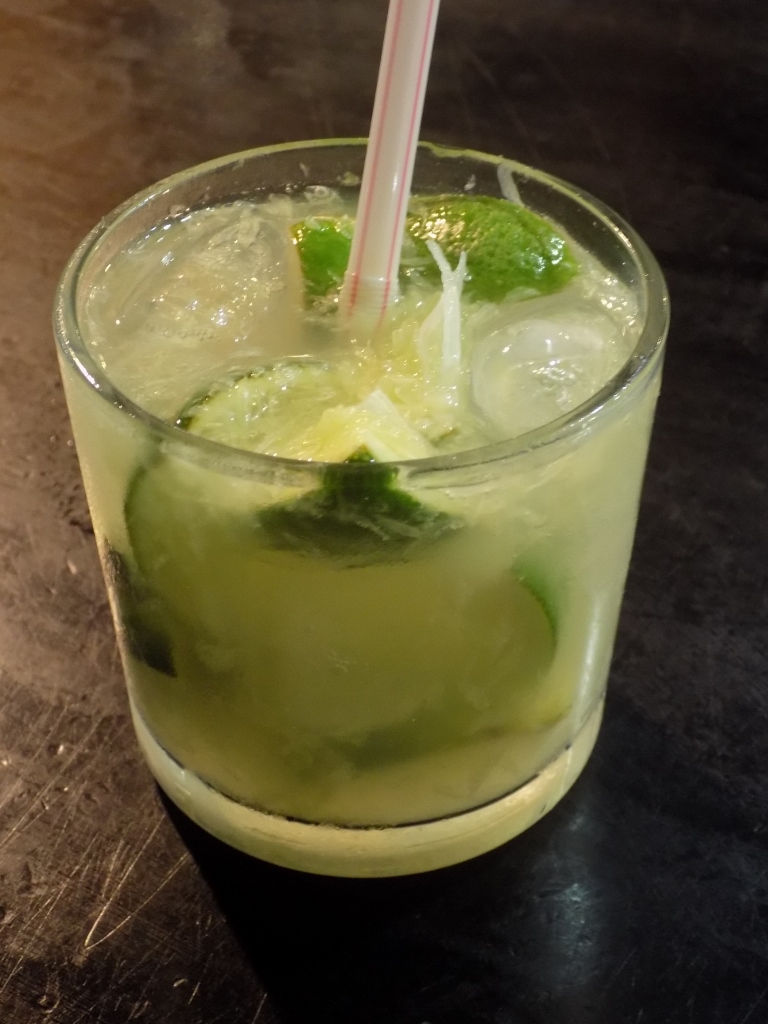 Caipirinha
Caipirinha
While we were sitting there, we watched the passers-by and tourists, as well as the women in traditional dresses which they now wear more because of the tourists and in an attempt to lure them into some of the restaurants or shops (during the day).
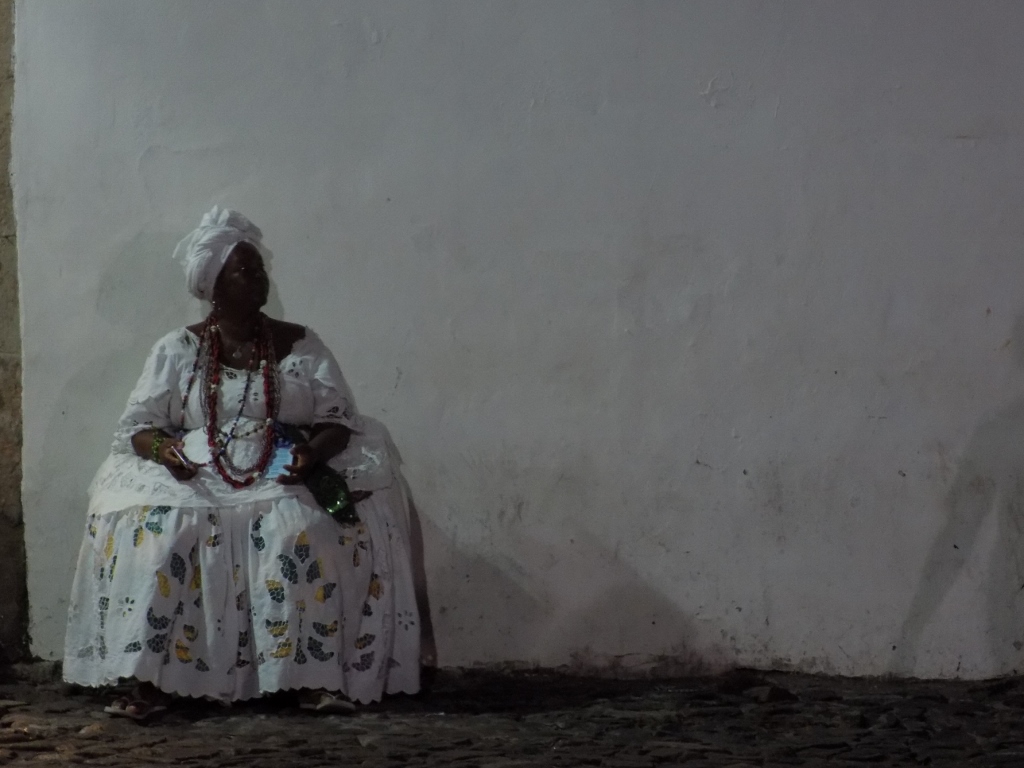 Salvador at night
Salvador at night
Then we decided to walk slowly back to the flat we had. The centre of Salvador through which we passed seemed fantastically attractive and we really looked forward to visiting it again, but in the daylight.
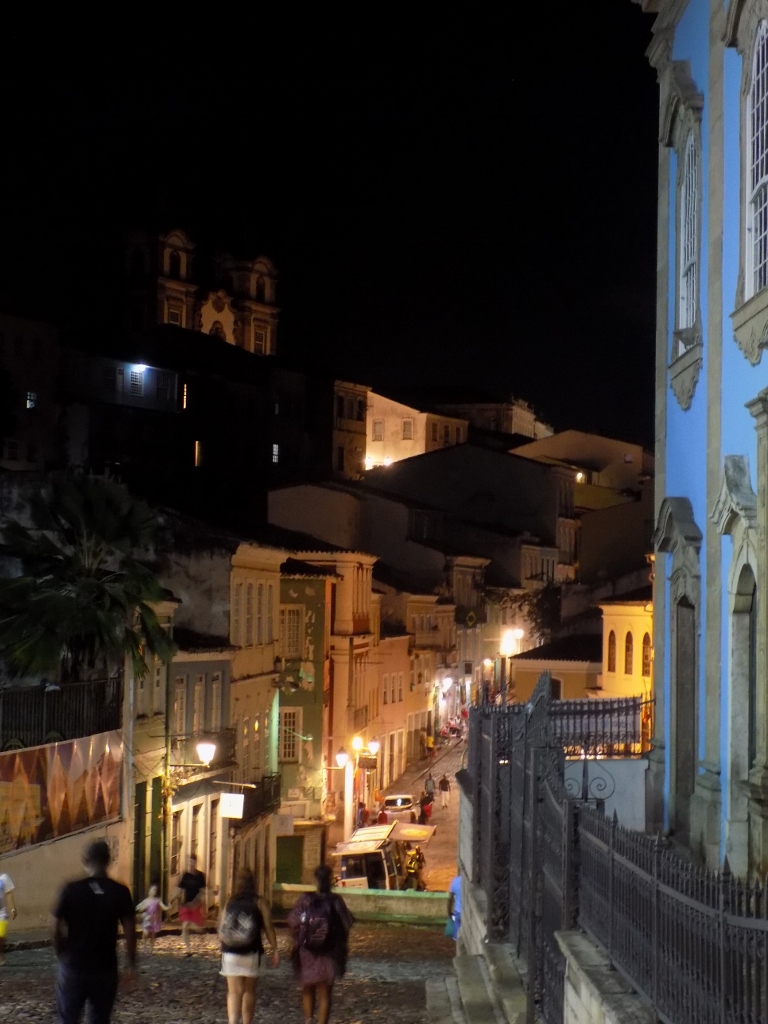 Salvador at night
Salvador at night
When we started to get ready to go to bed, we realised that the people in our little street with excellent acoustics which was faced by our living room had absolutely no intention to follow suit and go to bed.